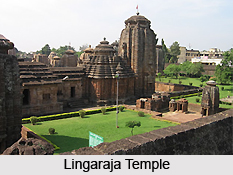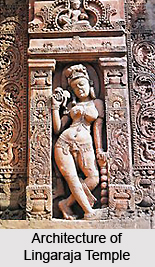 The Lingaraj temple - the largest among all, about a thousand years old, is a stupendous specimen of the Orissan style of temple building. The most distinguished of all temples in Bhubaneswar, dedicated to Lord Shiva, the 180 foot high temple with a jagamohana, natamandir and bhogamandapa is surrounded by a massive wall of a 7 feet thickness. The temple comprises of a profusion of sculptural work dating back to 1014 AD to the Somavamsis. The spacious courtyard filled with more than 100 shrines, remains unparalleled.
The Lingaraj temple - the largest among all, about a thousand years old, is a stupendous specimen of the Orissan style of temple building. The most distinguished of all temples in Bhubaneswar, dedicated to Lord Shiva, the 180 foot high temple with a jagamohana, natamandir and bhogamandapa is surrounded by a massive wall of a 7 feet thickness. The temple comprises of a profusion of sculptural work dating back to 1014 AD to the Somavamsis. The spacious courtyard filled with more than 100 shrines, remains unparalleled.
History:
The Lingaraj temple was constructed in 617-657 A.D with a height of about 54 meters. The temple is said to have been primarily built by the ruler Yayati Kesari in the 7th century who repositioned his capital from Jaipur to Bhubaneshwar. Bhubaneshwar remained as the Kesari capital, till Nripati Kesari founded Cuttack in the 10th century. Inscriptions from the period of the Kalinga King Anangabhima III from the 13th century are observed here. Jajati Keshari laid the foundation of the temple while his great grandson dispatched the work. The temple was fabricated at the site of an old seventh century shrine. The `nata mandapa` (dance hall) and `bhoga mandapa` (offerings hall) were soon added to the temple, thus evolving over distinct historical periods.
 Until, the Lingaraja temple was built, the Jagannath cult had grown to be extensive throughout Orissa. The presiding deity of the temple is the Svayambhu Linga- - half Shiva, half Vishnu, a unique feature of the temple.The Lingaraja complex encompasses 150 shrines, exceedingly appealing in their own right. The conspicuous feature of the temple is that, almost all Hindu Gods and Goddesses are represented here, thereby mirroring the inherent element of harmony within the religion.
Until, the Lingaraja temple was built, the Jagannath cult had grown to be extensive throughout Orissa. The presiding deity of the temple is the Svayambhu Linga- - half Shiva, half Vishnu, a unique feature of the temple.The Lingaraja complex encompasses 150 shrines, exceedingly appealing in their own right. The conspicuous feature of the temple is that, almost all Hindu Gods and Goddesses are represented here, thereby mirroring the inherent element of harmony within the religion.
Architecture:
Enclosed by elevated walls on four sides, the Lingaraja temple is one of the most eminent temples in Orissa. A fine example of the architectural excellence, attained by the artists in the 11th century, is also popularly known as the Bhubaneshwar temple. The outer walls of the temple exhibit exemplary carving while the skillfully sculpted metaphors of various God and Goddess remain truly unmatched. Moreover, the temple tower is visible from a considerable distance. The Shivalingam in the sanctum of the Lingaraja temple rises to a height of 8 inches above the floor level, and is 8 feet in diameter. The temple complex comprises of three parts, each of them consisting of one temple. Towards the southern direction of the entrance to the main temple appears the image of Lord Ganesha, followed by Nandi pillar. Its soaring spire-like beauty dominates the Bhubaneswar skyline. It represents the peak of Kalinga style of architecture spanning over 25 centuries of progressive history. This 11th century temple is the culmination of architectural beauty and sculpted elegance. The temple is dedicated to "Tri Bhubaneshwar", or Lord of the three worlds also known as Bhubaneshwar. The granite block representing "Tri Bhubaneshwar" is bathed daily with water, milk and Bhang (Marijuana). The temple surroundings consist of four primary features - a sanctuary, a dancing hall, an assembly hall and a hall of offerings.
The legends indicate that, Lord Siva brought out to Parvati that Bhubaneshwar - or Ekamra thirtha was a resort favored by him over Benares. Parvati in the guise of a cowherd woman, decided to have a glance at the city herself. Two demons Kritti and Vasa expressed the desire to marry her. She requested them to carry her upon their shoulders, and later crushed them under her weight. Shiva, then created the Bindu Saras lake to quench her thirst, and took abode here as Krittivasas or Lingaraja.
Worship: A total of 22 worship services are offered at the temple each day and an image of the Lingaraja is taken to the Jalamandir in the center of the Bindu Sagar Lake once a year.





















